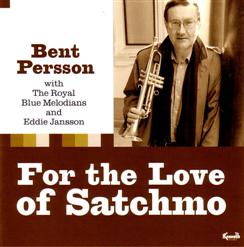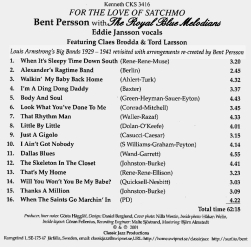I hated to see this wonderfully expansive concert — Bent Persson’s marvelous evocations of big-band Louis Armstrong — come to an end. These final seven selections explore Louis’s Decca period, here defined as 1935-41.
A word about the Deccas — appropriate not only because of this concert, but because of the recent Mosaic box set. As a body of work, they have provoked both defensive overpraise and criticism built on misunderstanding. At this distance, readers who wish to see the Swing Era as a high point in creative improvised music have found it necessary to forget that the material the bands and musicians were given to record was of variable quality — popular music from films and Broadway shows, music meant for dancers. Yes, a Porter, Berlin, Coslow, or Gershwin song could find its way in to the record session, but Ellington was playing CALL OF THE CANYON at Fargo.
But this constant influx of new songs was not a bad thing. Left to their own devices, many of the jazz artists we revere operate within a narrow repertoire, whether it is bounded by the blues and I GOT RHYTHM or a half-dozen other favorite songs. We all admire what the 1936-40 Basie band did within such constraints, but this makes TAXI WAR DANCE and TICKLE-TOE all the more delightful. So I don’t perceive Louis as shackled and victimized by Jack Kapp and Joe Glaser. His band was ragged at times, and I can hear the terrifying sound of Bingie Madison’s clarinet even now, but Kapp made the right choices more often than not: repeating a take so that the clarinet passage would be in tune would have required Louis to play more and more, not a wise or generous use of his energies.
Bent and the band do these majestic recordings justice and more: watching this concert is as close as I or anyone else will come to seeing Louis circa 1938, a magical experience. And both he and the band are using the recordings as frameworks for improvisation: the band plays Bent’s versions of the arrangements, and his solos are certainly shaped by what Louis played, but they are variations on variations — alternate takes, if you will — rather than exact attempts at reproducing what Louis played in the studios.
They began with that truly pretty tune (Louis didn’t play the verse, which is a pity — ask Jon-Erik Kellso to do it if the band knows the changes) from the film of the same name, THANKS A MILLION. And the sweetly ethereal Elena P. Paynes of the Chicago Stompers shows us that expressing our gratitudes is always a good thing, as is Martin Litton’s pretty, ruminative solo chorus:
Bent took over the dramatic leadership of the next song — really a playlet, as acted by Louis in his first leap into film stardom, in PENNIES FROM HEAVEN — a clip I’ve posted elsewhere on this blog. “The fun was loud and hearty, when a notorious wallflower became the life of the party!” Here’s THE SKELETON IN THE CLOSET:
I assume that Louis was asked to perform ALEXANDER’S RAGTIME BAND, already a hoary standard, because of the musical film of the same name. It’s a difficult arrangement, with Technicolor trappings (the march-band opening) and on the original Decca, even Louis has a moment’s trouble finding where he is . . . but Elena is in fine form, even given the wordy lyrics and the fast tempo:
I DOUBLE DARE YOU is a pretty swing tune, one that should have gotten more attention in its time — now, it seems the only people who play and sing it are trumpeters. Would that there were other singers inviting us all to “get friendly” in Ludvig Carlson’s amiable way! And there are some fine instrumental solos — Clerc, McQuaid, Munnery, and Bonnel — all backed by Nick Ward’s rocking drums:
SO LITTLE TIME isn’t musically complex, but Louis made something splendid out of it (as he did with TRUE CONFESSION and RED CAP); Elena makes this Swing version of tempus fugit truly winsome, and Bent adds his own majesty:
In the idealized Chicago period (the years some listeners think of as Louis’s only peak), Tommy Rockwell of OKeh Records wouldn’t let him record WHEN THE SAINTS GO MARCHING IN on the grounds of impiety. Lucky for us that Jack Kapp’s musical world-view was broader, thus making it possible for Louis to explore this hymn as well as IN THE GLOAMING and ON A COCOANUT ISLAND. Reverends Persson and Paynes offer a “mellow sermon” for us all:
Finally, Bent pays homage to Louis’s moving instrumental examination of the song he played in fragments every night for forty years — WHEN IT’S SLEEPY TIME DOWN SOUTH. Luxuriant, I say:
Video recordings may give you a sense of what it was like to be there — not only the sound, but the musicians smiling at something perfectly apt that someone else has played or sung. But videos are still not designed to be played in the car (unless you’re a lucky bored passenger) so I happily recommend an earlier compact disc recording of some of this material — a different band, solos, and vocals, but our Bent and Claes Brodda are there . . . so you know the heights will be scaled! The project was issued on the late Gosta Hagglof’s Kenneth label as FOR THE LOVE OF SATCHMO, and the backing band is the very empathic and hot Royal Blue Melodians. Ordering details can be found on the blogroll: click on “Classic Jazz Productions.” (You’ll also find the CDs of Bent and friends playing Louis’s Hot Choruses and breaks, astonishing music.)


A million thanks to everyone involved in this concert.

Pingback: BENT PERSSON PLAYS LOUIS: Conclusion